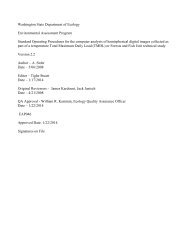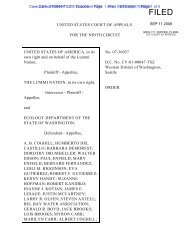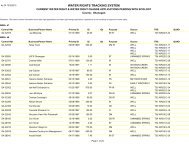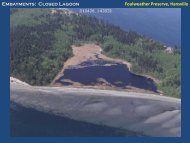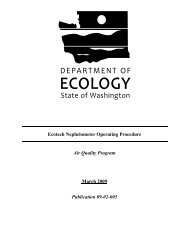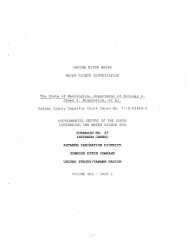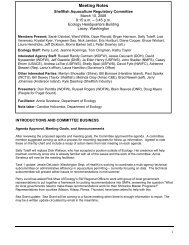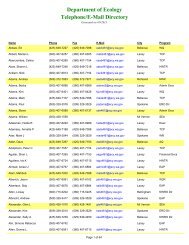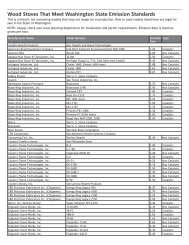General Permit for Biosolids Management - Washington State ...
General Permit for Biosolids Management - Washington State ...
General Permit for Biosolids Management - Washington State ...
You also want an ePaper? Increase the reach of your titles
YUMPU automatically turns print PDFs into web optimized ePapers that Google loves.
<strong>General</strong> <strong>Permit</strong> <strong>for</strong> <strong>Biosolids</strong> <strong>Management</strong> Page 9<br />
“Site” means all areas of land, including buffer areas, which are identified in the scope of an approved<br />
Site Specific Land Application Plan. A site is considered to be new or expanded when biosolids are<br />
applied to an area not approved in a Site Specific Land Application Plan or that was not previously<br />
disclosed during a required public notice process.<br />
“Specific oxygen uptake rate (SOUR)” is the mass of oxygen consumed per unit time per unit mass of<br />
total solids (dry weight basis) in the biosolids.<br />
“<strong>State</strong>” means the state of <strong>Washington</strong>.<br />
“Store or storage of biosolids” is the placing of biosolids on land or in surface impoundments or other<br />
containment devices in which the biosolids remain <strong>for</strong> 2 years or less, except where a greater time<br />
period has been approved by Ecology. This does not include the placing of biosolids on land or in surface<br />
impoundments or other containment devices <strong>for</strong> treatment or disposal.<br />
“Stover” is the nongrain, above-ground part of a grain crop, often corn or sorghum.<br />
“Surface impoundment” means a facility or part of a facility which is a natural topographic depression,<br />
man-made excavation, or diked area <strong>for</strong>med primarily of earthen materials (although it may be lined<br />
with man-made materials), and which is designed to hold an accumulation of liquids or sludges. The<br />
term includes holding, storage, settling, and aeration pits, ponds, or lagoons, but does not include<br />
injection wells.<br />
“Surface waters of the state” means surface waters of the state as defined in WAC 173-201A-020.<br />
“Tank” means a stationary device designed to contain an accumulation of liquid or semisolid materials<br />
and which is constructed primarily of nonearthen materials to provide structural support.<br />
“Temporary, small-scale storage” is the storage of biosolids <strong>for</strong> no more than 30 days in a tank holding<br />
no more than 10,000 gallons with a total on-site maximum volume of no more than 20,000 gallons.<br />
“Total solids” are the materials in biosolids that remain as residue when the biosolids are dried at 103 to<br />
105 C (217.4 to 221°F).<br />
“Treat or treatment of biosolids” is the preparation of biosolids <strong>for</strong> final use or disposal. This includes,<br />
but is not limited to, thickening, stabilization, and dewatering of biosolids. This does not include storage<br />
of biosolids.<br />
“Treatment works treating domestic sewage” means a publicly owned treatment works or any other<br />
sewage sludge or wastewater treatment devices or systems, regardless of ownership, used in the<br />
storage, treatment, recycling, and reclamation of municipal or domestic sewage or sewage sludge,<br />
including land dedicated <strong>for</strong> the disposal of sewage sludge. Treatment works treating domestic sewage<br />
also includes beneficial use facilities and septage management facilities as defined in this section, and a<br />
person, site, or facility designated as a treatment works treating domestic sewage in accordance with<br />
WAC 173-308-310(1)(b). This definition does not include septic tanks or similar devices or temporary,<br />
small-scale storage as defined in this section.<br />
“Treatment works” is either a federally owned, publicly owned, or privately owned device or system<br />
used to treat (including recycle and reclaim) either domestic sewage or a combination of domestic<br />
sewage and industrial waste of a liquid nature.<br />
“Unstabilized solids” are organic materials in biosolids that have not been treated in either an aerobic<br />
or anaerobic treatment process.<br />
“Vector attraction” is the primarily odorous characteristic of biosolids that attracts rodents, flies,<br />
mosquitoes, or other organisms capable of transporting infectious agents.<br />
“Volatile solids” is the amount of the total solids in biosolids that are lost when the biosolids are<br />
combusted at 550 C (1,022°F) in the presence of excess air.<br />
“Waters of the state” means waters of the state as defined in RCW 90.48.020.



